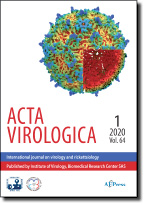Journal info
|
||
Select Journal
Journals
Bratislava Medical Journal Endocrine Regulations General Physiology and Biophysics Neoplasma Acta Virologica Current articles 2023 2022 2021 2020 2019 2018 2017 2016 2015 2014 2013 2012 2011 2010 2009 2008 2007 2006 2005 2004 2003 Studia Psychologica Cardiology Letters Psychológia a patopsych. dieťaťa Kovove Materialy-Metallic Materials Slovenská hudbaWebshop Cart
Your Cart is currently empty.
Info: Your browser does not accept cookies. To put products into your cart and purchase them you need to enable cookies.
Acta Virologica Vol.48, p.257-262, 2004 |
||
| Title: PROPERTIES OF A VIRUS ISOLATED FROM VERNONIA AMYGDALINA DEL. IN LAGOS, NIGERIA | ||
| Author: M.A. TAIWO, J. DIJKSTRA | ||
| Abstract: A previously uncharacterized virus tentatively named Vernonia green vein-banding virus (VGVBV) was isolated from Vernonia amygdalina Del. (“bitterleaf”) from Lagos, Nigeria. The virus was mechanically transmissible but had a narrow host range restricted to Nicotiana benthamiana, Chenopodium quinoa and C. amaranticolor. It was also transmissible in a non-persistent manner by Myzus persicae. The virus was purified from N. benthamiana and about 750 nm long flexuous rod-shaped particles were observed in purified preparations as well as in leaf–dips of Vernonia sp. Inclusion bodies in the form of pinwheels and scrolls were observed in ultrathin sections of Vernonia leaves by electron microscopy. Mr of the viral coat protein was estimated to be about 34 K. In indirect ELISA, all 20 samples from naturally infected Vernonia sp. reacted positively with a potyvirus-specific monoclonal antibody (MAb) as well as with an antiserum raised against VGVBV. Apart from the homologous antigen, the VGVBV antiserum reacted only with Plum poxvirus (PPV). The VGVBV reacted strongly with the antisera to Bean yellow mosaic virus (BYMV), Bean common mosaic virus (BCMV) and Amaranthus leaf mottle virus (AmLMV) but weakly with antisera to PPV and Cowpea aphid-borne mosaic virus (CABMV) (all members of the family Potyviridae, the genus Potyvirus) in at least one of the assays used (indirect ELISA, dot-blot immunoassay and Western blot analysis). The results of our host range, cytopathological and serological studies and the available literature indicate that a hitherto difficult to transmit VGVBV has only been reported from Nigeria. We consider VGVBV a candidate for a new potyvirus. This virus should be further investigated to collect sufficient data for a qualified proposal of VGVBV as a new potyvirus. |
||
| Keywords: Vernonia amygdalina Del.; Vernonia green vein-banding virus; potyvirus | ||
| Year: 2004, Volume: 48, Issue: | Page From: 257, Page To: 262 | |
|
|
 download file download file |
|

